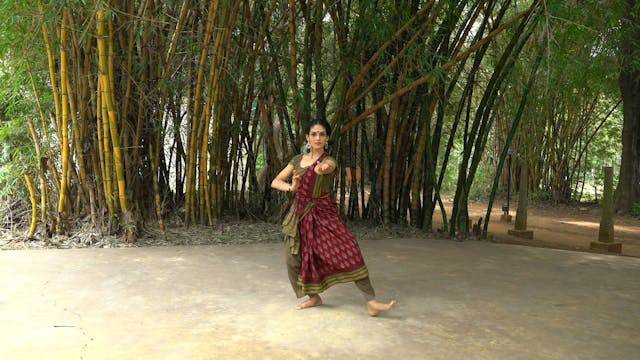Pakkadavu 2
Playlist 11
•
3m 33s
Pointers for Pakkadavu 2:
Keep your shoulders down when stretching your arms.
Keep the height of the arm that you are looking away from. It is common to let this arm go too far back or let it drop below shoulder height.
Keep your head straight when you look to the side.
Make sure you keep your thighs pushing back while retaining Swastikam in your feet.
The Pakkadavu name is derived from the movement of the entire body as opposed to a name derived from specifically the articulation of the feet. The Raadha Kalpa method practises four different types of Pakkadavu to create specificity in feet articulation. The movement of the arms are interchangeable and can be varied to an even greater number when placed in choreography.
The four types that are introduced, address with clarity four types of feet articulation in combination with most commonly used arm movements.
This progression is unique to the Raadha Kalpa method as it changes the starting and ending of each Pakkadavu by changing the use of Tattu in Araimandi or Swastikam.
Pay specific attention to the feet articulation in the Pakkadavu series. Start with the first one and then progress to the rest.
Up Next in Playlist 11
-
Teermana Adavu 1
The Theermana or Makutadavu, is placed at the end of a Korwe or Jathi in specific rhythmic patterns, to create an ending.
The leg is either placed outstretched directly in front or at a diagonal of 45 degrees. The foot is flexed and the heel strikes the floor. In the Raadha Kalpa method we begi...
-
Theermana Adavu 1, variation
The Theermana or Makutadavu, is placed at the end of a Korwe or Jathi in specific rhythmic patterns, to create an ending.
The leg is either placed outstretched directly in front or at a diagonal of 45 degrees. The foot is flexed and the heel strikes the floor. In the Raadha Kalpa method we begi...
-
Theermana Adavu 2
The Theermana or Makutadavu, is placed at the end of a Korwe or Jathi in specific rhythmic patterns, to create an ending.
The leg is either placed outstretched directly in front or at a diagonal of 45 degrees. The foot is flexed and the heel strikes the floor. In the Raadha Kalpa method we begi...


